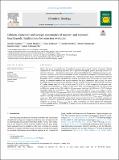Files in this item
Lithium elemental and isotope systematics of modern and cultured brachiopods : implications for seawater evolution
Item metadata
| dc.contributor.author | Gaspers, Natalie | |
| dc.contributor.author | Magna, Tomáš | |
| dc.contributor.author | Jurikova, Hana | |
| dc.contributor.author | Henkel, Daniela | |
| dc.contributor.author | Eisenhauer, Anton | |
| dc.contributor.author | Azmy, Karem | |
| dc.contributor.author | Tomašovych, Adam | |
| dc.date.accessioned | 2021-11-19T10:30:05Z | |
| dc.date.available | 2021-11-19T10:30:05Z | |
| dc.date.issued | 2021-12-30 | |
| dc.identifier | 276254318 | |
| dc.identifier | 915162f2-fd8b-4466-8374-c7e14cfb286d | |
| dc.identifier | 85118890945 | |
| dc.identifier | 000720228300004 | |
| dc.identifier.citation | Gaspers , N , Magna , T , Jurikova , H , Henkel , D , Eisenhauer , A , Azmy , K & Tomašovych , A 2021 , ' Lithium elemental and isotope systematics of modern and cultured brachiopods : implications for seawater evolution ' , Chemical Geology , vol. 586 , 120566 . https://doi.org/10.1016/j.chemgeo.2021.120566 | en |
| dc.identifier.issn | 0009-2541 | |
| dc.identifier.uri | https://hdl.handle.net/10023/24370 | |
| dc.description | This study was funded by the European Union's Horizon 2020 research and innovation programme under the grant agreement No. 643084 - Marie Sklodowska-Curie Innovative Training Network (ITN) ‘BASE-LiNE Earth’. | en |
| dc.description.abstract | Lithium has proven a powerful tracer of weathering processes and chemical seawater evolution. Skeletal components of marine calcifying organisms, and in particular brachiopods, present promising archives of Li signatures. However, Li incorporation mechanisms and potential influence from biological processes or environmental conditions require a careful assessment. In order to constrain Li systematics in brachiopod shells, we present Li concentrations and isotope compositions for 11 calcitic brachiopod species collected from six different geographic regions, paralleled with data from culturing experiments where brachiopods were grown under varying environmental conditions and seawater chemistry (pH–pCO2, temperature, Mg/Ca ratio). The recent brachiopod specimens collected across different temperate and polar environments showed broadly consistent δ7Li values ranging from 25.2 to 28.1‰ (with mean δ7Li of 26.9 ± 1.5‰), irrespective of taxonomic rank, indicating that incorporation of Li isotopes into brachiopod shells is not strongly affected by vital effects related to differences among species. This results in Δ7Licalcite–seawater values (per mil difference in 7Li/6Li between brachiopod calcite shell and seawater) from −2.9‰ to −5.8‰ (with mean Δ7Licalcite–seawater value of −3.6‰), which is larger than the Δ7Licalcite–seawater values calculated based on data from planktonic foraminifera (~0‰ to ~−4‰). This range of values is further supported by results from brachiopods cultured experimentally. Under controlled culturing conditions simulating the natural marine environment, the Δ7Licalcite–seawater for Magellania venosa was −2.5‰ and not affected by an increase in temperature from 10 to 16 °C. In contrast, a decrease in Mg/Ca (or Li/Ca) ratio of seawater by addition of CaCl2 as well as elevated pCO2, and hence low-pH conditions, resulted in an increased Δ7Licalcite-seawater up to −4.6‰. Collectively, our results indicate that brachiopods represent valuable archives and provide an envelope for robust Li-based reconstruction of seawater evolution over the Phanerozoic. | |
| dc.format.extent | 12 | |
| dc.format.extent | 5459970 | |
| dc.language.iso | eng | |
| dc.relation.ispartof | Chemical Geology | en |
| dc.subject | Lithium isotopes | en |
| dc.subject | Brachiopod calcite | en |
| dc.subject | Controlled culturing experiements | en |
| dc.subject | Seawater history | en |
| dc.subject | Paleo-proxy | en |
| dc.subject | QE Geology | en |
| dc.subject | T-NDAS | en |
| dc.subject | SDG 14 - Life Below Water | en |
| dc.subject.lcc | QE | en |
| dc.title | Lithium elemental and isotope systematics of modern and cultured brachiopods : implications for seawater evolution | en |
| dc.type | Journal article | en |
| dc.contributor.institution | University of St Andrews. School of Earth & Environmental Sciences | en |
| dc.identifier.doi | 10.1016/j.chemgeo.2021.120566 | |
| dc.description.status | Peer reviewed | en |
This item appears in the following Collection(s)
Items in the St Andrews Research Repository are protected by copyright, with all rights reserved, unless otherwise indicated.

